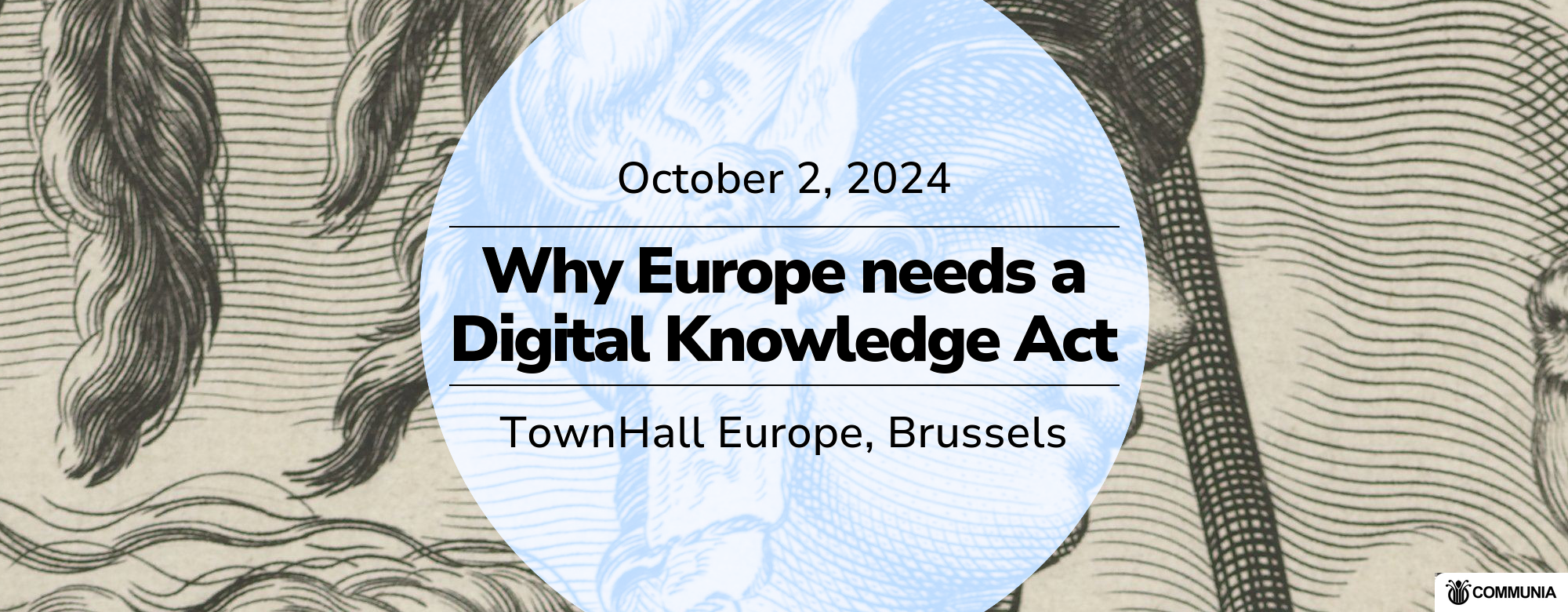COMMUNIA and Gesellschaft für Freiheitsrechte co-hosted the Filtered Futures conference on 19 September 2022 to discuss fundamental rights constraints of upload filters after the CJEU ruling on Article 17 of the Directive on Copyright in the Digital Single Market (CDSMD). This blog post is based on the author’s contribution to the conference’s first session “Fragmentation or Harmonisation? The impact of the Judgment on National Implementations.” It is published under a Creative Commons Attribution 4.0 International licence (CC BY 4.0).
Article 17 of Directive (EU) 2019/790 on copyright in the Digital Single Market (CDSMD) has been subject to much debate even before its enactment. The latest twist is the CJEU’s ruling in the Polish action for annulment of Article 17 CDSMD. Uncertainties about the precise and correct practical application of Article 17 CDSMD remain. The judgment, however, provides some clarity on how this norm must be transposed into national law to ensure compliance with fundamental rights, particularly with freedom of expression and information as enshrined in Article 17(2) of the Charter of Fundamental Rights of the European Union.
Compatibility of verbatim transpositions and why the German approach is ahead of the pack
Article 17 CDSMD is open to various interpretations – as has become clear during the hearings before the CJEU. While Spain and France argued that an implementation of ex post safeguards is sufficient to protect user rights, the CJEU later confirmed the position taken by the Advocate General and Member States like Germany that Article 17 CDSMD’s ex post safeguards must necessarily be supplemented by ex ante safeguards. These should address the danger of overblocking, that is the undue blocking of lawful content by OCSSPs before its dissemination in order to comply with the obligations from Article 17(4) CDSMD.
The judgment emphasises the need for ex ante safeguards against rampant blocking under Article 17(4) CDSMD. This fact, together with the obligation for Member States, when transposing Article 17 CDSMD, to strike a fair balance between the various fundamental rights, have raised doubts about the compatibility of verbatim transpositions. Other commentators have rejected these, arguing that minimal verbatim transposition is necessary to avoid impairing the harmonisation effect of the Directive.
The CJEU did not concern itself with national transpositions, but rather solely Article 17 CDSMD in its original version, and found an interpretation in compatibility with the freedom of expression. The CJEU held that Article 17(4) CDSMD is accompanied by appropriate safeguards. The judgment requires Member States to ensure an interpretation of national provisions that contains these safeguards.
As the judgment itself already identifies an interpretation of the Article in line with fundamental rights, the same must surely also apply to identical wording (i.e., copy and paste transpositions) in national law. This has to be the case as Member States are bound to interpret their laws in line with the CJEU’s interpretation. National courts, when interpreting national law, must have regard to the case law of the CJEU. Therefore, a conforming interpretation of verbatim transpositions should be ensured. As a consequence, copy and paste transpositions must be considered compatible with the judgment and the fundamental right to freedom of expression.
This does not mean, however, that this kind of implementation is the best in the face of freedom of expression and information. Instead, a more elaborative implementation, which provides more details on the delineation of permitted and prohibited ex ante blocking, should be the preferable way forward.
A conceivably elaborative implementation is the German version of Article 17 CDSMD, as it was transposed in the act on the copyright liability of OCSSPs (UrhDaG). One aspect of particular interest is the concept of a “presumed legal use”. In summary, Germany established a national additional ex ante safeguard for content which either qualifies as minor usage or is marked by the user as legally permitted. Under certain requirements, this content is presumed to be lawful and therefore cannot be blocked by automated means implemented by the OCSSPs. If rightholders contest this content, they have to initiate the complaint procedure, which may result in the content being taken down.
While there is an ongoing discussion about the compatibility of the German mechanism with the EU template, it is true that it dares to do something that had been missing from the EU Directive: it defines circumstances under which ex ante blocking is not possible.
The need for a definition of “manifestly infringing”
It has to be said that while this constitutes a step in the right direction, the current German provisions may not be the ultimate solution. Rightholders argue that even the unjustified usage of a film sequence as short as 15 seconds can significantly harm their economic interests, when only blocked after an ex post intervention. Nevertheless, the German transposition puts requirements in black and white for the design and use of automated content recognition (ACR) technology and automated blocking based on it.
In order to protect freedom of expression, it is important to be more specific about the requirements and circumstances under which automated ex ante blocking of content is permissible. One of the key points from the judgment in the Polish case is that for content to be blocked ex ante without freedom of expression being unjustifiably harmed, no independent assessment of its unlawfulness must be necessary. In other words, content needs to be “manifestly infringing”, which makes this term the central standard for determining whether the prevention of an upload was lawful or not.
Therefore, it should not be left to OCSSPs to determine when content is infringing enough to be regarded as manifestly infringing and can thus lawfully be blocked automatically. Rather, regulators should find ways to define requirements. This would not only provide clarity to users, rightholders and platforms, but deployed at the EU level it would also contribute to the harmonisation objective.
The implementation of the German legislator may serve as a starting point. However, it only defines circumstances under which automated blocking is not permissible, i.e., when manifestly infringing content is not present. Therefore, the law only gives a hint of a negative definition. A positive definition, which indicates when content can be blocked automatically, has yet to be found.
Implications of the judgment for the design of the complaint mechanism
In the context of national transpositions of Article 17 CDSMD, two remarks regarding current questions of implementation should be made.
The first concerns national provisions in respect of the complaint mechanism as set out in Article 17(9) CDSMD. From the judgment in the Polish case, we know that the complaint mechanism is considered as an additional (ex post) safeguard, which applies in “cases where, notwithstanding the [ex ante] safeguards […], the providers of those services nonetheless erroneously or unjustifiably block lawful content” (para 93).
The complaint mechanism is therefore intended to deal with cases where there is a dispute as to whether the content is manifestly infringing. In those cases, however, it is in the nature of things that the content in question stays offline for the duration of the complaint mechanism. This presupposes that the basic requirements for ex ante safeguards have been implemented and that the ex post complaint mechanism only applies in exceptional cases. It is only under these conditions that provisions like the Italian one under which all contested content shall remain disabled for the duration of the complaint procedure can be considered compatible with the judgment.
The Commission’s category of “earmarked content” needs revision
The second aspect relates to earmarked content as mentioned in the Commission’s Guidance on Article 17. The Guidance defines earmarked content as content flagged by rightholders that is particularly valuable and could cause them significant harm if it remains available without authorization (examples include pre-released music or films). According to the Guidance, earmarked content should be specifically taken into account when assessing whether OCSSPs have made their best efforts to ensure the unavailability of content.
What is highly problematic about this provision, however, is that OCSSPs would be forced to exercise particular care and diligence in this case, which would ultimately result in a higher blocking rate and ignore the requirements of the judgment in the Polish annulment action. As a solution, the Commission presents rapid ex ante human review in the Guidance, which takes place for such earmarked content before the content gets online, when detected by the filters.
This, however, does not comply with Article 17(8) CDSMD and what follows from the Glawischnig-Piesczek and recent Poland cases. According to these cases, a provider can only be required to remove content where a detailed legal examination is not necessary. And, although framed as “rapid ex ante review”, this is nothing other than a detailed legal examination.
Therefore, the Commission needs to revise its Guidance on this point and Member States should choose an implementation of earmarked content which respects the case law. A possible solution could be to use an earmark mechanism not ex ante but ex post. Content which is marked by rightholders as of significant economic value and matches content uploaded by users could be processed through an accelerated complaint procedure. This would be similar to what Article 19 of the Digital Services Act (DSA) establishes.
The DSA needs to fix Article 17 CDSMD
The DSA raises hopes for more harmonisation of details related to the interpretation of Article 17 CDSMD. Due to a largely overlapping scope of application for OCSSPs in the area of copyright, it can be assumed that the DSA provisions apply on the basis of a lex generalis relationship to Article 17 CDSMD. Provisions such as Article 17 DSA, that sets out detailed rules for a complaint mechanism, or Article 19 DSA, with its trusted flagger regime, could influence the way Article 17 CDSMD works in practice.
Due to its nature as a regulation, the DSA should lead to greater harmonisation. In order to achieve this, it would in addition be necessary to use the aforementioned revision of the Guidance to develop a positive definition of manifestly infringing content which can be used as a basis for designing the algorithms of OCSSPs.

